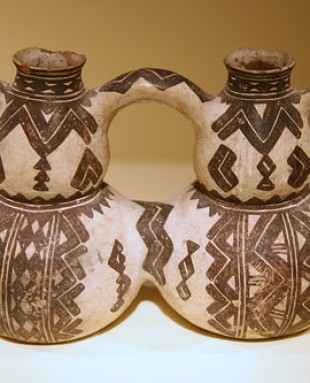The inhabitants of the mountainous Kabyle region along the Mediterranean coast in northeastern Algeria are primarily farmers. They are also superb artists noted for their jewelry making, textiles, mats, basketry, pottery and house mural decoration. In North Africa, wheel-thrown pottery made by men dates from the 7th century B.C. when the Phoenicians introduced the potter’s wheel to the Algerian coast. Handbuilt pottery made by women, including those from the Kabyle, an older, probably indigenous tradition, dates back 2000 years before the birth of Christ. The vessel depicted here originates from earlier prototypes. To this day, Kabyle women coil and decorate pottery with beautiful painted geometric designs for their own household use and for sale. Kabyle women handbuild vessels of various sizes and shapes for holding water, milk, oil, cooking and eating food, and oil lamps. This vessel (thibuk’alin) was probably created for local use. It is composed of two interconnected containers joined at the neck and body by two channels through which liquid can flow. Each container has a pouring spout. Such vessels may have been used to pour libations or offerings during a ritual. This vessel, colored with white slip, decorated with black geometric designs and with a short, thick body and flat bottom, probably originated in the Little Kabyle area in eastern Algeria. The zigzag designs may refer to either a serpent or a fish, both thought to have apotropaic functions to counter evil. The bottom of this pot contains a potter’s mark consisting of a rectangular shape with cross-hatched lines.
Duka Eleven
Just another DukaPress Shop


